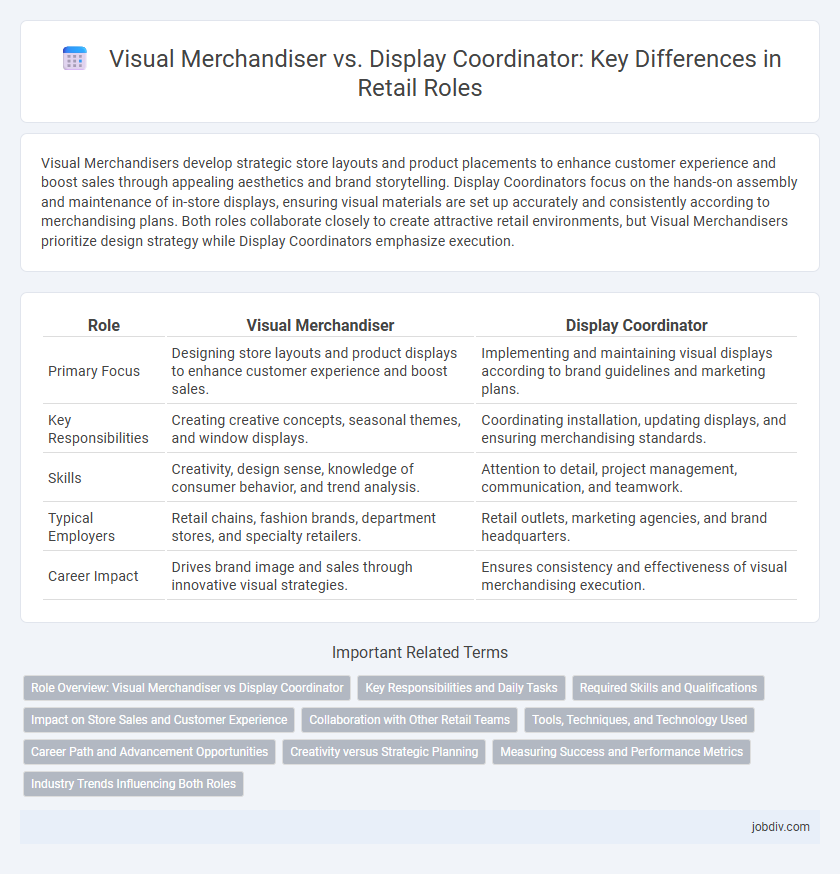Visual Merchandisers develop strategic store layouts and product placements to enhance customer experience and boost sales through appealing aesthetics and brand storytelling. Display Coordinators focus on the hands-on assembly and maintenance of in-store displays, ensuring visual materials are set up accurately and consistently according to merchandising plans. Both roles collaborate closely to create attractive retail environments, but Visual Merchandisers prioritize design strategy while Display Coordinators emphasize execution.
Table of Comparison
| Role | Visual Merchandiser | Display Coordinator |
|---|---|---|
| Primary Focus | Designing store layouts and product displays to enhance customer experience and boost sales. | Implementing and maintaining visual displays according to brand guidelines and marketing plans. |
| Key Responsibilities | Creating creative concepts, seasonal themes, and window displays. | Coordinating installation, updating displays, and ensuring merchandising standards. |
| Skills | Creativity, design sense, knowledge of consumer behavior, and trend analysis. | Attention to detail, project management, communication, and teamwork. |
| Typical Employers | Retail chains, fashion brands, department stores, and specialty retailers. | Retail outlets, marketing agencies, and brand headquarters. |
| Career Impact | Drives brand image and sales through innovative visual strategies. | Ensures consistency and effectiveness of visual merchandising execution. |
Role Overview: Visual Merchandiser vs Display Coordinator
Visual Merchandisers strategize product placement and store layouts to enhance customer engagement and drive sales, utilizing market trends and consumer behavior analytics. Display Coordinators execute the physical setup of promotional and seasonal displays, ensuring compliance with brand standards and visual guidelines. Both roles collaborate closely to create cohesive in-store experiences that optimize product visibility and strengthen brand identity.
Key Responsibilities and Daily Tasks
Visual Merchandisers develop and implement creative store layouts and product displays to enhance customer engagement and drive sales. Display Coordinators manage the installation and maintenance of visual displays, ensuring brand consistency and alignment with marketing campaigns. Both roles require collaboration with marketing teams and store managers to optimize the in-store shopping experience.
Required Skills and Qualifications
Visual Merchandisers require strong creative design skills, expertise in consumer behavior analysis, and proficiency in visual storytelling to enhance brand identity and drive sales. Display Coordinators need excellent organizational abilities, project management experience, and technical skills in setting up retail displays according to brand guidelines and seasonal campaigns. Both roles benefit from knowledge of retail trends, collaboration skills, and proficiency in relevant software like Adobe Creative Suite or 3D modeling tools.
Impact on Store Sales and Customer Experience
Visual Merchandisers strategically design store layouts and product displays to enhance brand identity and attract customer attention, directly boosting store sales through increased foot traffic and impulse purchases. Display Coordinators ensure consistent execution and maintenance of visual standards, creating an engaging shopping environment that improves customer experience and encourages repeat visits. Both roles collaboratively influence retail performance by combining creative design with operational precision, optimizing sales potential and customer satisfaction.
Collaboration with Other Retail Teams
Visual Merchandisers collaborate closely with marketing, sales, and store management teams to create cohesive brand experiences and drive customer engagement through strategic product placement and attractive displays. Display Coordinators work primarily with inventory and logistics teams to ensure timely installation and maintenance of visual elements, optimizing presentation and operational efficiency. Both roles require strong communication and teamwork skills to align visual strategies with overall retail goals and seasonal promotions.
Tools, Techniques, and Technology Used
Visual Merchandisers utilize advanced 3D design software, digital planograms, and augmented reality tools to create immersive retail environments that enhance customer engagement. Display Coordinators rely on practical tools such as graphic boards, signage printers, and inventory management systems to implement and maintain in-store displays efficiently. Both roles integrate data analytics platforms and project management software to optimize layout effectiveness and streamline workflow, but Visual Merchandisers emphasize creative visual storytelling while Display Coordinators focus on operational execution.
Career Path and Advancement Opportunities
Visual Merchandisers typically start by creating compelling in-store displays and can advance to managerial roles such as Visual Merchandising Manager or Creative Director, overseeing brand aesthetics across multiple locations. Display Coordinators often begin with hands-on installation and maintenance of retail displays, progressing to supervisory or project management positions within store operations or marketing departments. Both roles offer growth opportunities through gaining expertise in consumer psychology, trend analysis, and cross-functional collaboration with buying and marketing teams.
Creativity versus Strategic Planning
Visual Merchandisers emphasize creativity by designing appealing store layouts and product displays that capture customer attention and enhance brand image. Display Coordinators focus more on strategic planning, organizing display installations to align with marketing campaigns, inventory cycles, and sales goals. Both roles collaboratively drive retail success by balancing innovative visual appeal with effective operational execution.
Measuring Success and Performance Metrics
Visual Merchandisers measure success through increased sales, customer engagement, and brand consistency across store layouts, focusing on metrics like conversion rates and average transaction value. Display Coordinators evaluate performance by monitoring the effectiveness of individual displays, using foot traffic analysis and promotional response rates to optimize visual impact. Both roles rely on key performance indicators such as inventory turnover and customer dwell time to refine merchandising strategies and maximize retail profitability.
Industry Trends Influencing Both Roles
Industry trends such as the rise of experiential retail and integration of digital technology are transforming the roles of Visual Merchandisers and Display Coordinators. Visual Merchandisers increasingly incorporate augmented reality and interactive displays to enhance customer engagement, while Display Coordinators focus on optimizing physical layouts and ensuring brand consistency across multiple store locations. Both roles must adapt to sustainability initiatives and data-driven insights to create visually compelling and socially responsible retail environments.
Visual Merchandiser vs Display Coordinator Infographic

 jobdiv.com
jobdiv.com